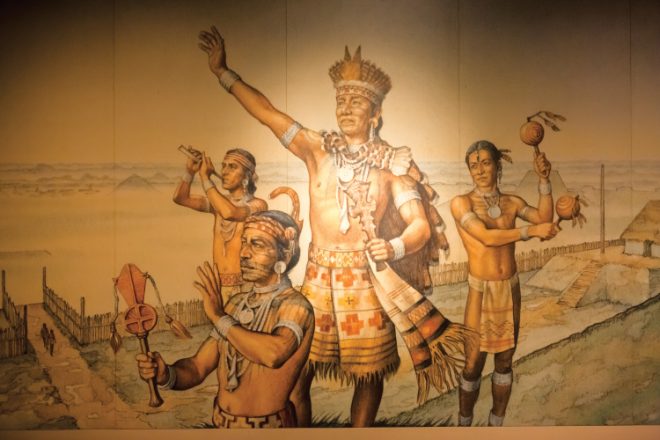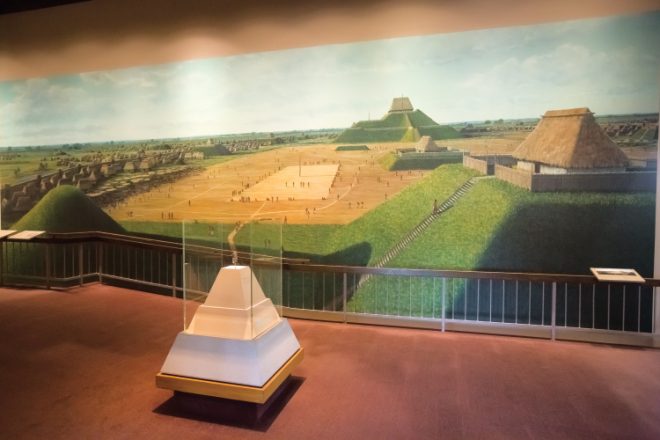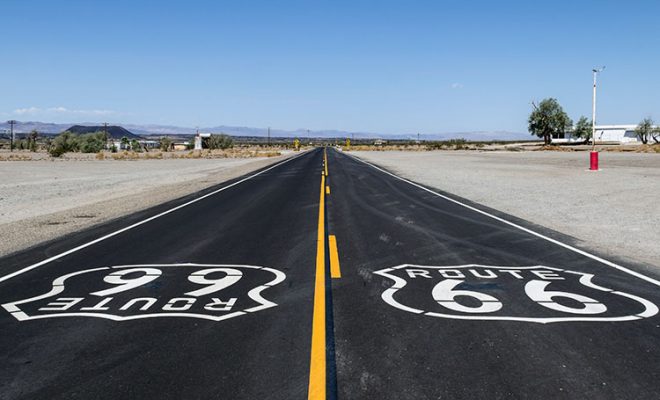
Past meets present just west of Collinsville, where a mammoth mound touches the sky. Today, Monks Mound stands watch over the buzzing Interstate 55 corridor. But centuries ago, it surveyed the City of the Sun: Cahokia.
Mysterious Mounds
Far from the first mound builders, Cahokians made the most mounds – 120 in three varieties – and the most impressive.
Monk’s Mound looms 100 feet high and sprawls across 14 acres at its base, making it the largest earthen mound in North America. Cahokia’s commoners carried 55-pound baskets of dirt to create the flat-topped mound built in stages over 150 years. Its purpose remains crystal clear.
“Platform or temple mounds are a way of elevating important people and activities,” says archaeologist Bill Iseminger, assistant manager at the Cahokia Mounds State Historic Site. “Monks Mound was a seat of power.”
The same could be said of the city itself.

Birth of a City
Between A.D. 1050 and 1150, Cahokia’s population peaked as high as 20,000, making it larger than London at the time – and no less influential.
“Cahokia is the largest prehistoric Indian settlement north of Mexico,” says Iseminger, author of Cahokia Mounds: America’s First City. “We use the term ‘city’ when we talk about Cahokia because of its size, complexity and the supporting communities around it.”
America’s earliest city grew from agriculture. Cahokia’s first farmers specialized in squash and domesticated plants such as sunflowers and lambsquarters, for their oily and starchy seeds. But corn put this city on the map.
“Around A.D. 900, corn becomes a major food source,” Iseminger says. “They could produce large quantities of corn, and it was easily storable and durable.”
Drawn by a stable food source, more people began to settle in Cahokia. Archaeologists dubbed a population explosion around A.D. 1050 the “Big Bang.”

“People were moving in from other places like northern Arkansas and southern Indiana,” says Iseminger, noting corn as just one catalyst. “Something was drawing people in – perhaps a charismatic leader or a new religion.”
Cahokia Mounds State Historic Site & Interpretive CenterIf You Go...
Location: 30 Ramey St. in Collinsville
Hours: Wednesday through Sunday, 9 a.m. to 5 p.m.
Phone: (618) 346-5160
cahokiamounds.org
The surplus of corn gave leaders great power and established Cahokia as a major trading center.
“There was a lot of trade going on in Cahokia,” Iseminger says. “We’ve found a tremendous amount of seashells from the Gulf of Mexico, copper from Lake Superior and mica from southern Appalachia.”
Markets periodically filled the city’s 50-acre Grand Plaza, also the venue for festivals, religious ceremonies and games such as “chunkey,” a version of the hoop and stick game using a stone disc.
The planned community of farmers, artisans, astronomers and mound-makers thrived until around A.D. 1150. But its very size led to its demise.
Death of a City
The city’s dense population – 4,000 people per square mile – led to malnutrition, disease, pollution and depletion of natural resources. Making matters worse, a gradual cooling in the climate and extended droughts took a toll on crops. As resources became scarcer, conflict grew more common.
“Just before 1200, we begin to see evidence of conflict and warfare,” notes Iseminger. “Sites were fortified with walls, and we see war injuries, such as broken forearms from fending off war club blows.”
Gradually, Cahokia’s residents began to leave.

Piecing Together the Puzzle
Ongoing research seeks to better understand life at Cahokia. However, artifacts such as the famous “Birdman” tablet (an engraved sandstone showing a winged man) and even the evidence of ritual human sacrifice often raise more questions than they answer.
“Archaeology is like putting a puzzle together without all the pieces,” says Iseminger, who has devoted his 45-year career to piecing together the story of Cahokia.
Today, as a National Historic Landmark and World Heritage Site, international historians recognize Cahokia as one of prehistory’s great cities.
“People tend to think of Peru and Mexico when they think of these large, complex sites and cultures,” Iseminger says. “But we had it here, too.”


